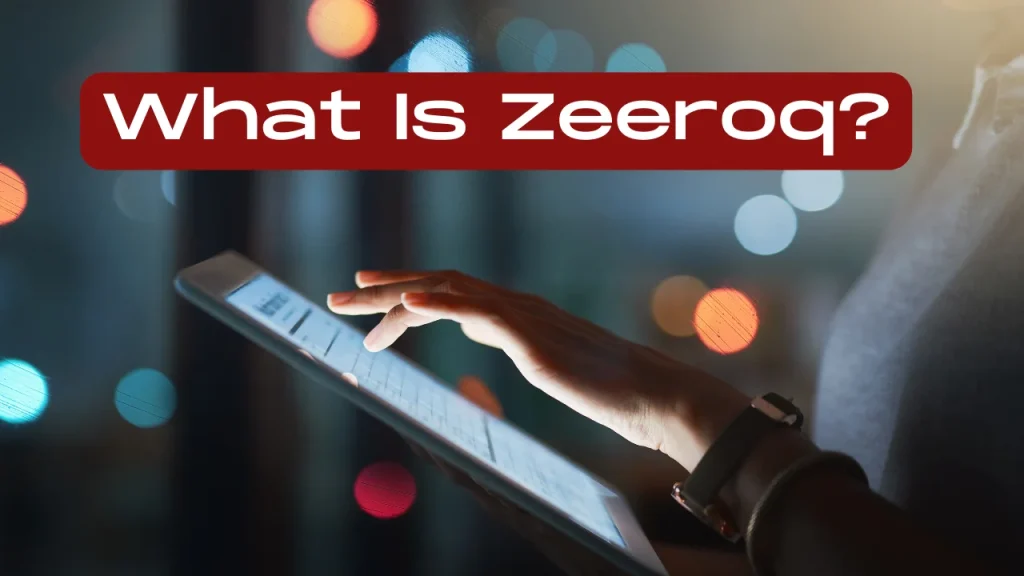When people’s faith in one another is betrayed in the digital realm, it can have far-reaching and rapid effects. The news of a massive data breach at Zeeroq.com shocked the cybersecurity community in January 2024. Not only did this event serve as a wake-up call for businesses, but it also exposed, vulnerableized, and left millions of users uncertain. With far-reaching consequences across sectors, the Zeeroq breach has become a textbook example of how even modern platforms can be hit by bad cybersecurity practices.
What Is Zeeroq?

The website Zeeroq.com was well-known for managing massive amounts of user data across various digital services. Its rapid demise occurred after hackers took advantage of significant vulnerabilities in its infrastructure, despite its growing reputation for data-driven insights and business automation solutions. Security researchers estimate that Zeeroq had 226 million user records, making it one of the biggest breaches of early 2024. Both Zeeroq’s security flaw and the critical need for improved privacy standards in the tech sector were brought to light by this incident.
The Zeeroq Breach Dissected
How the breach was discovered
Some of the first cybersecurity companies to notice the compromised Zeeroq data on dark web platforms were InsecureWeb and PurePrivacy. A hacker going by the name of “Chucky” allegedly posted the stolen database on the notorious hacker website leakbase.io. Although records indicate that unauthorized access had happened weeks earlier, the breach was publicly disclosed on February 10, 2024. Users and data protection advocates both voiced their disapproval of the delay in notification.
Types of data compromised
The Zeeroq hack affected more than just login credentials. According to the analysts, the following sensitive information was leaked:
Names, phone numbers, and physical addresses.
Weakly protected email addresses and hashed passwords.
There were instances where credit card details and transaction records were exposed.
Crimes like financial fraud, phishing, and identity theft became much more likely as a result of this extensive data breach.
Volume of data exposed
Estimates from Avast Community and Coruzant Technologies suggest over 226 million individual records were breached. This sheer volume placed Zeeroq among the most severe cybersecurity incidents of the decade. Here’s a quick comparison table with similar breaches:
| Company | Records Exposed | Type of Data Leaked | Year of Breach |
| Zeeroq.com | 226 Million | Personal, Financial, Login | 2024 |
| Equifax | 147 Million | SSNs, Credit Info | 2017 |
| 533 Million | Phone Numbers, Emails | 2019 | |
| T-Mobile | 40 Million | Personal, Account Data | 2021 |
Who was responsible for the breach
The unknown hacker responsible for the Zeeroq cybersecurity breach went by the alias “Chucky,” a name familiar to members of underground cyber forums. But Chucky’s message on dark web channels suggested ideological rather than financial motivations, so maybe it’s not Chucky at all. No official attribution has been made public, but investigations by cybercrime units are still ongoing.
Just a few days after cybersecurity firms raised the alarm, Zeeroq formally informed users of the breach on February 10, 2024. Regrettably, substantial worries regarding openness and compliance with regulations were heightened by this postponement of disclosure. Many customers viewed the company’s delay in assessing the scale and verifying notification accuracy as an example of its lack of corporate responsibility.
How Zeeroq Handled the Fallout
Immediate steps taken
Zeeroq launched a comprehensive internal investigation after the breach was confirmed. They started finding vulnerabilities in the system and the source of the breach by working with outside cybersecurity experts and companies like Coruzant Technologies. Users were informed and encouraged to change their passwords, enable two-factor authentication, and keep a close eye on their bank statements all at the same time.
Security upgrades implemented
The technical team at Zeeroq revamped the company’s security system. Among these were:
Changing to protocols that encrypt data from beginning to end
Implementing monitoring systems for potential intrusions
Using two-factor authentication (2FA) to make logins more secure
Introducing curriculum for cybersecurity education to all employees
Restoring public faith and establishing new organizational operational standards were the goals of these reforms.
Collaboration with cybersecurity experts
In order to audit and rebuild the backend systems, the company hired well-known firms like PurePrivacy and InsecureWeb. No additional leaks have occurred since February 2024, according to these experts’ separate reports, despite the severity of the breach.
Public response and transparency
Despite the public’s intense scrutiny, Zeeroq decided to tackle the crisis directly. The corporation stressed responsibility, openness, and user security via regular blog posts and press releases. Their late but sincere effort to be transparent mitigated the blow and kept some users’ faith.
Legal and regulatory challenges
Several regulatory agencies are currently looking into allegations that Zeeroq violated data protection laws, such as the General Data Protection Regulation (GDPR) and the California Consumer Privacy Act (CCPA). The corporation might pay millions in fines if it is determined to be non-compliant.
What Data Was Leaked in the Zeeroq Cybersecurity Incident
Personal identifiers
Full names, residential addresses, and phone numbers were among the most worrying parts that were exposed. Anyone can use this data to commit fraud, target specific scams, or even impersonate another person.
Email addresses and passwords
The breach exposed more than 100 million unique email passwords. Beyond Zeeroq.com, the scope of the vulnerability expanded due to users reusing passwords across platforms.
Financial and transactional data
Over 1.2 million instances involved compromised payment information, including encrypted credit card numbers and purchase records. This paved the way for illicit trade and resale on the black market.
User activity logs
The breach also included information about user behavior, including login details, browser types, and location tracking. Although this information may not be immediately harmful, it could be utilized for ad fraud and social engineering.
Business account data
The internal team credentials and dashboards of a few business clients who used Zeeroq for marketing analytics were compromised. This was dangerous for businesses as a whole, not simply for individual users.
Protecting Yourself After the Zeeroq Hack
Reset your passwords immediately
Please update your password immediately if you have an account with Zeeroq.com. It is recommended that you use a password manager and refrain from reusing passwords.
Activate multi-factor authentication
Second factor authentication greatly improves safety. Even if credentials are compromised, enabling this feature in Zeeroq will prevent unauthorized access.
Monitor financial accounts
Make sure you closely monitor your banking and credit card statements. Get in touch with your bank right away if you see anything out of the ordinary.
Place fraud alerts on your credit
To report your account for possible fraud, contact the three main credit reporting agencies. This can prevent new accounts from being opened in your name.
Comparison of Security Actions Taken by Similar Companies
| Company | Breach Year | Notification Time | 2FA Mandated | External Audit |
| Zeeroq.com | 2024 | 10 Days Late | Yes | Yes |
| Equifax | 2017 | 6 Weeks Late | No | Yes |
| T-Mobile | 2021 | 3 Days | Yes | Yes |
| 2019 | 7 Days | No | No |
Zeeroq’s post-breach response was comparatively swift and transparent, though not immediate. The inclusion of 2FA and third-party audits marked a positive shift toward accountability.
Key Technical Flaws Behind the Breach
Cybersecurity professionals and independent analysts have gained a better understanding of the fundamental vulnerabilities that resulted in the platform’s compromise, even though Zeeroq has not disclosed all forensic details. When proactive security measures are disregarded, the vulnerability of a digital ecosystem becomes apparent, as these technical shortcomings demonstrate.
Outdated software components
Outdated software is often named as a cause of serious breaches. Based on findings from PurePrivacy and InsecureWeb, Zeeroq was found to be operating on various antiquated backend services, such as legacy database management systems and API gateways. Automated scripts and zero-day vulnerabilities were able to easily exploit these antiquated tools because they did not have the latest security patches.
Weak API authentication protocols
Application programming interfaces (APIs) play a pivotal role in enabling systems to communicate with one another. But according to reports, Zeeroq didn’t secure some of its internal APIs with strong token-based authentication. By using forged requests, attackers were able to bypass critical security checks and access data directly from backend servers.
Lack of network segmentation
Hackers could traverse Zeeroq laterally after gaining access through a weak point in the system’s architecture due to a lack of network segmentation. Without setting off any internal alarms, the attackers were able to steal sensitive information, including customer data, financial records, and admin-level credentials. Such movement should be restricted in a secure system by using separate data zones.
Lessons for Other Companies
Not only did Zeeroq’s team learn a hard lesson from the breach, but so did digital businesses around the world. According to numerous experts, this incident brought attention to the urgent need for reforms that contemporary digital platforms should seriously consider.
Implement zero trust architecture
According to zero trust, no system or user, even those behind a firewall, can be trusted on their own. This structure was missing from Zeeroq, which meant that their perimeter defenses were ineffective against lateral movement. Adopting a zero trust model will limit access and require constant re-authentication for all users and systems.
Regular penetration testing
There was scant indication that Zeeroq had budgeted for expert penetration testing prior to the incident. In order to find vulnerabilities that real attackers might miss, teams can use simulated cyberattacks to test their defenses. All companies should follow Zeeroq’s lead and implement quarterly pen tests after their breach.
Transparent breach response frameworks
The delay in disclosure was one of the most criticized actions by Zeeroq. Streamlined internal communication, user notifications, and regulatory compliance procedures are essential components of any modern organization’s breach response framework. No matter how bad things get, being open and honest will win you trust in the long run.
User Sentiment and Industry Reactions
The Zeeroq data breach affected public trust and the larger cybersecurity ecosystem, in addition to technical and corporate ramifications. User expectations and industry norms were transformed by the breach.
Customer trust decline
It caught Zeeroq’s users off guard. Data that was both personal and sensitive for businesses had been entrusted to the platform by many. Reddit and TrustPilot saw a precipitous decline in public opinion as users questioned the security measures employed by the seemingly progressive company. This loss of confidence affected neighboring platforms that were thought to be just as vulnerable as Zeeroq.
Industry call for accountability
The breach’s permissive practices were swiftly denounced by cybersecurity communities. Security experts from Avast and Coruzant Technologies have demanded more stringent industry-wide compliance measures, particularly for platforms that deal with large amounts of user data. Many prominent figures have called on governments to strengthen cybersecurity regulations and mandate SaaS providers to have valid cybersecurity certifications.
Ripple effect across tech startups
Businesses in the tech industry, particularly those in the fields of marketing automation, CRM, and e-commerce, hastened to reassess their security measures. At cybersecurity conferences, the Zeeroq incident was used as an example of how investments in security should never be prioritized over speed-to-market.
Security Measures Comparison
To help businesses and users better understand the importance of cybersecurity layers, here’s a comparative table showcasing typical security features among Zeeroq and related platforms after the breach:
| Platform | 2FA Support | End-to-End Encryption | Network Segmentation | Regular Pen Testing | Public Breach Response |
| Zeeroq.com | Yes | Yes (Post-breach) | No (Initially) | Yes (Post-breach) | Moderate |
| HubSpot | Yes | Yes | Yes | Yes | Strong |
| ActiveCampaign | Yes | Yes | Partial | No | Limited |
| Mailchimp | Yes | Yes | Yes | Yes | Strong |
This table underscores the industry standards Zeeroq is now trying to meet. Businesses should benchmark their own systems using similar metrics.
Frequently Asked Questions
Was my information exposed in the Zeeroq breach?
If you had an account with Zeeroq before January 2024, your data was likely exposed. Check your email for breach notifications and use dark web monitoring tools to confirm.
Is Zeeroq.com still safe to use?
After implementing extensive security upgrades, Zeeroq.com is significantly safer than before. However, caution is always advised.
Who was behind the Zeeroq data leak?
A hacker known as “Chucky” has taken responsibility. Law enforcement is investigating the identity and motives.
What steps has Zeeroq taken after the breach?
Zeeroq upgraded its infrastructure, launched public disclosures, and partnered with cybersecurity experts for system audits.
How can I protect myself now?
Update your passwords, use 2FA, monitor your credit, and consider identity theft protection services.
Also Read: AnonVault: The Ultimate Encrypted Cloud Storage for Privacy & Security
Conclusion
A sobering reminder of the price of ignoring cybersecurity is the 2024 Zeeroq data breach. This wasn’t merely an internal failure; it became a public crisis when more than 226 million records were exposed, impacting individuals, businesses, and the trust fabric of the digital world. The transformation, though, began with this breach. Zeeroq has shown a renewed dedication to user security and data protection with its extensive reforms.




